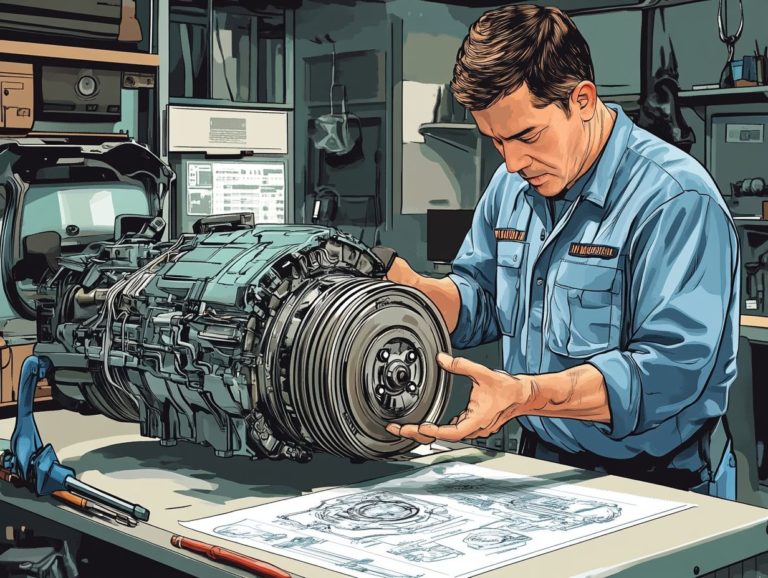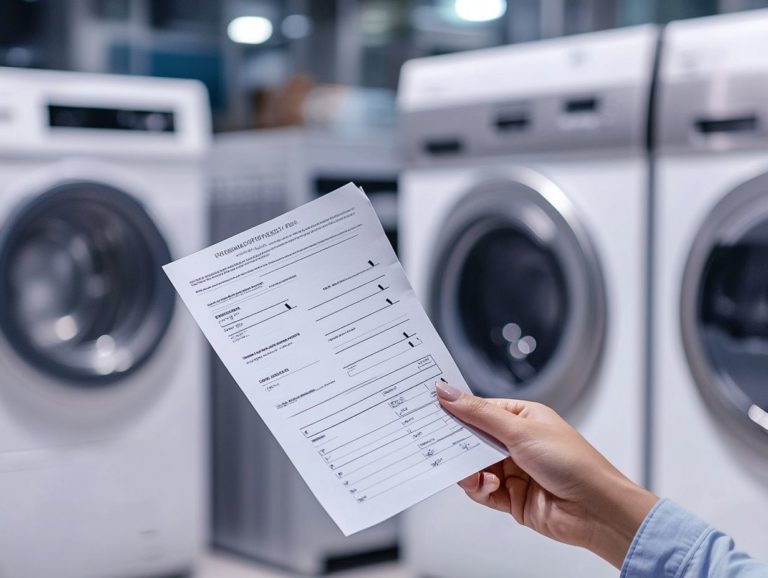The Importance of Timing Belt Replacement
A timing belt is essential to your vehicle’s engine, orchestrating the movement of various components with precision.
Recognizing its function and identifying the signs of wear can prevent costly repairs and ensure your engine operates seamlessly.
This guide provides all the information you need about timing belts when to replace them, the process involved, and the factors that influence replacement costs.
Stay informed to keep your vehicle in top shape. This knowledge helps you avoid unexpected breakdowns.
Contents
- Key Takeaways:
- What is a Timing Belt?
- Signs that a Timing Belt Needs to be Replaced
- Importance of Replacing a Timing Belt
- When to Replace a Timing Belt
- How to Replace a Timing Belt
- Cost of Timing Belt Replacement
- Frequently Asked Questions
- What is the purpose of a timing belt in a vehicle?
- How often should a timing belt be replaced?
- What happens if a timing belt is not replaced on time?
- How can I tell if my timing belt needs to be replaced?
- Is it necessary to replace other components when replacing a timing belt?
- Can I replace a timing belt myself?
Key Takeaways:

- Replace your timing belt to prevent expensive engine repairs and ensure it runs smoothly.
- Watch for signs of wear, such as noise and vibration, signaling the need for a timing belt replacement.
- Follow recommended mileage and time intervals for timing belt replacement to keep your engine functioning optimally.
What is a Timing Belt?
A timing belt is an essential element of your car’s engine, playing a pivotal role in keeping the crankshaft and camshaft in perfect harmony.
This rubber belt ensures that your engine’s valves open and close precisely when they should, allowing for peak performance.
The timing belt works with other vital engine parts, like the water pump and tensioner. Regular maintenance and timely replacement are key for optimal performance.
Definition and Function
The timing belt is a critical element in your vehicle’s maintenance regimen, acting as the essential link that ensures proper engine synchronization.
This key component connects the crankshaft to the camshaft, enabling them to work in perfect harmony by opening and closing the engine’s valves at precisely the right moments.
This synchronization is vital for achieving optimal engine performance; any misalignment can lead to a multitude of issues, including reduced fuel efficiency and the risk of serious engine damage.
Thus, regular inspection and timely replacement of the timing belt are essential parts of your routine vehicle care. Overlooking this task can lead to expensive repairs, underscoring the timing belt’s significance not only in enhancing performance but also in extending the life of your engine.
Signs that a Timing Belt Needs to be Replaced
Know when to replace your timing belt. This protects your engine from damage and keeps your vehicle running well.
Keep an eye out for common signs of wear, such as fraying, cracking, and oil leaks these can all be easily spotted with regular visual inspections. If you overlook these indicators, you might find yourself facing more serious problems, like timing belt failure, which could lead to costly engine repairs.
Indicators of Wear and Tear
Look for signs of wear on your timing belt, such as cracks, fraying, and strange noises. These could indicate serious issues.
If you notice an abnormal increase in engine vibrations, especially during start-up, it s crucial to investigate further. Be vigilant for engine misfires or rough idling, as these could signal that your timing belt isn t performing as it should.
Symptoms related to tensioners, such as a whining sound while driving, may suggest that the belt or its associated components are loose or worn. Additionally, noisy idler bearings or those that show signs of play can significantly heighten the risks linked to a failing timing belt.
As a vehicle owner, monitor these signs closely. Timely maintenance can save your engine s health.
Importance of Replacing a Timing Belt

Replacing your timing belt is critical to avoid costly engine damage. A worn belt can lead to serious engine problems, which no car owner wants to experience. It’s important to know when you should replace your timing belt to prevent these issues.
Understanding the risks is key to keeping your engine safe. Neglecting the timing belt replacement schedule in your vehicle manual can result in catastrophic failures. By keeping your timing belt in good condition, you ensure optimal engine performance and reliability.
Preventing Costly Damage
Timely replacement of your timing belt is essential to prevent costly damage and ensure your engine’s longevity. Knowing when to replace your car’s timing belt can help you maintain your vehicle effectively.
Ignoring this important maintenance can lead to severe engine issues, resulting in hefty repair bills. By recognizing the signs of wear and tear and committing to regular inspections, you can maintain optimal performance and avoid unexpected breakdowns.
Consult a reputable car repair service for guidance on the recommended replacement intervals for your specific vehicle model.
Taking these proactive steps saves you money in the long run and enhances your vehicle’s overall reliability and efficiency.
Ensuring Engine Performance
Optimal engine performance relies heavily on the condition of your timing belt and timely service appointments for its replacement.
A well-maintained timing belt is essential for ensuring the engine’s internal components work together smoothly, preventing power loss that occurs when the belt is worn or damaged. If this crucial part fails, it can lead to misalignment, causing a drop in your engine s efficiency and power.
By replacing the timing belt on schedule, you significantly reduce the risk of overheating a common issue when the engine’s valves and pistons go out of sync.
The connection between the timing belt’s condition and your vehicle’s performance is clear. Ignoring this essential maintenance can lead to costly repairs and decreased reliability.
When to Replace a Timing Belt
Knowing when to replace your timing belt is essential for every car owner. This timing can vary significantly based on your vehicle s make and model, often detailed in the owner s manual.
Most manufacturers recommend replacement at specific mileage intervals, typically between 60,000 and 100,000 miles, to avoid timing belt failure and potential engine damage. Understanding these intervals allows you to budget for these expenses and effectively plan your vehicle’s maintenance schedule.
Recommended Mileage and Time Intervals
Recommended mileage intervals for timing belt service generally fall between 60,000 and 100,000 miles, but this may vary based on your vehicle’s make and model.
For instance, if you drive a Honda, the manufacturer may suggest replacing the timing belt around 105,000 miles. Meanwhile, Toyota often recommends intervals closer to 90,000 miles for many of its models. Always consult your owner s manual or a trusted mechanic to stay informed on this crucial maintenance.
Neglecting it could lead to serious engine damage and high repair costs. Keeping track of these intervals not only protects your engine s health but also improves your vehicle s overall performance.
How to Replace a Timing Belt

Replacing a timing belt is best left to expert technicians, but understanding the process helps you ensure quality service for your vehicle.
This step-by-step guide outlines the essential procedures for replacing a timing belt, such as removing the timing cover. It s crucial to use OEM parts (Original Equipment Manufacturer), as these are made by the same company that built your vehicle.
Familiarizing yourself with these key elements will enhance your knowledge and help you communicate effectively with your mechanic, ensuring your car receives the best care possible.
Step-by-Step Guide
A step-by-step guide to timing belt replacement begins with gathering the necessary tools and materials. Consult a certified technician to ensure best practices are followed. This approach guarantees your automotive needs are met while maintaining essential safety standards.
Proper preparation involves checking the car s manual for specific instructions. Ensure your workspace is clean and have all necessary tools like wrenches and torque specifications ready.
During the removal process, pay careful attention to detail. Disconnect any components that block access to the timing belt and note how each part is positioned for reinstallation.
When installing, handle everything meticulously, maintaining the right alignment and tension to avoid future headaches. After the replacement, conducting a thorough inspection is vital to ensure everything functions smoothly, helping you prevent unexpected breakdowns.
Cost of Timing Belt Replacement
The cost of replacing a timing belt can vary significantly based on several factors, including your vehicle s make and model, local labor rates, and whether you re replacing additional components like the water pump simultaneously.
Understanding the nuances of timing belt costs is crucial for effective budgeting and planning for necessary automotive repairs.
Factors Affecting Cost
Several factors impact the cost of replacing your timing belt. Choose between original parts made by the vehicle manufacturer or aftermarket alternatives. The specific demands of professional auto repair services also play a role.
In addition to parts selection, labor costs significantly affect overall repair expenses. Skilled technicians often charge varying rates influenced by their experience and regional market conditions.
If complications arise like engine misalignment or coolant leaks you may need additional repairs, driving up the total cost. Some vehicles might require specialized tools or equipment for the replacement process, leading to added expenses.
Taking all these factors into account is essential for gaining a clear understanding of the total budget needed for this critical maintenance task.
Frequently Asked Questions
What is the purpose of a timing belt in a vehicle?

The timing belt is a crucial component in a vehicle that helps synchronize the rotation of the engine’s camshaft and crankshaft. This ensures that the engine’s valves open and close at the precise time for proper combustion, providing power to the vehicle.
How often should a timing belt be replaced?
The recommended replacement interval for a timing belt varies, but it typically ranges from 60,000 to 100,000 miles. Check your vehicle’s manual to stay informed about the specific replacement interval.
What happens if a timing belt is not replaced on time?
If a timing belt is not replaced on time, it can break or slip, causing major engine damage. This could lead to costly repairs and even engine failure. Following the recommended replacement interval is essential to avoid these problems.
How can I tell if my timing belt needs to be replaced?
Signs that it might be time to replace your timing belt include squealing or rattling noises from the engine, difficulty starting the vehicle, and visible cracks or fraying on the belt. If you notice any of these signs, schedule a mechanic inspection today!
Is it necessary to replace other components when replacing a timing belt?
Yes, it s recommended to replace components such as the water pump, tensioner, and idler pulleys when replacing a timing belt. These components work together and are often located in the same area. Replacing them at the same time is more cost-effective and helps avoid future issues.
Can I replace a timing belt myself?
Replacing a timing belt is not easy. It requires special tools and knowledge.
Don’t risk your engine! Hire a skilled mechanic who can replace your timing belt safely.






